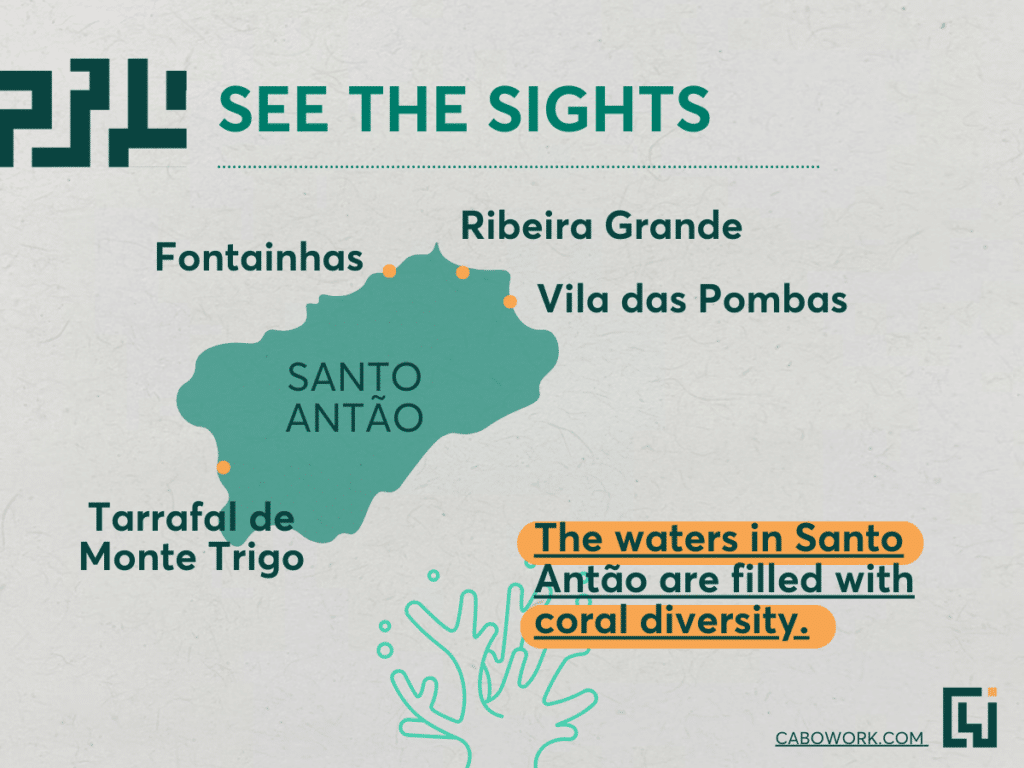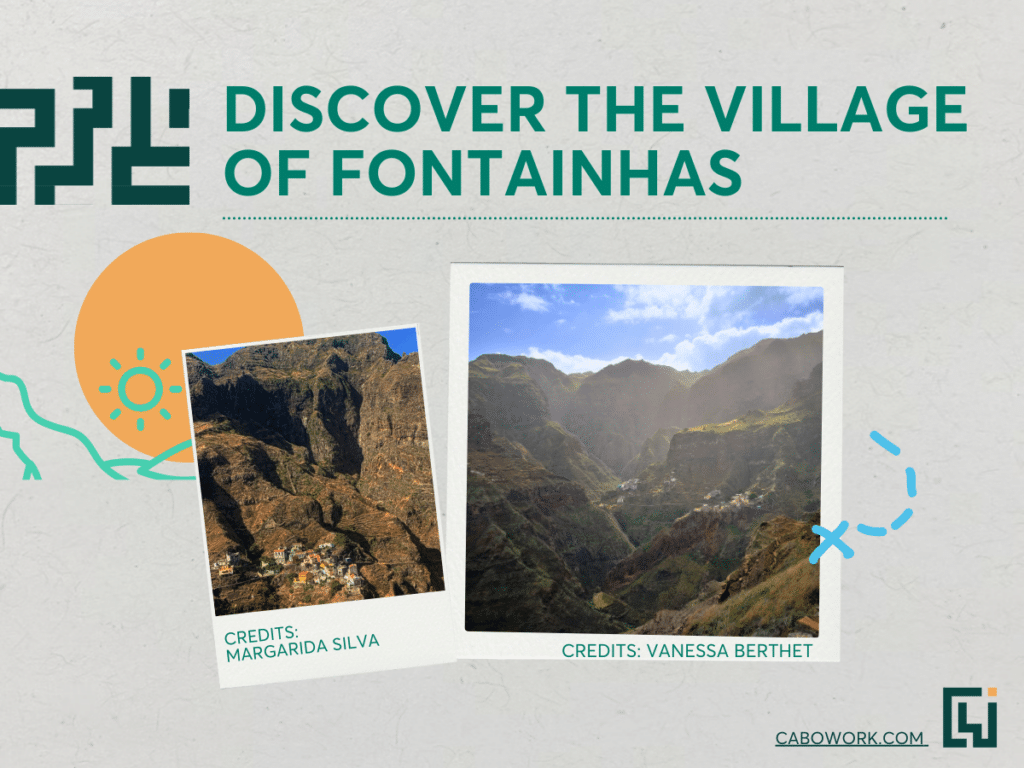This article contains Booking affiliate links. We earn from qualifying purchases, with no extra cost to you. Any revenue earned goes back into making Cabowork the best platform for all things Cape Verde!
Digital Nomad Guide to Santo Antão: Key Takeaways
- Conquer challenging hiking trails like Ponta do Sol to Chã de Igreja or Cruzinha.
- Combine work in Mindelo’s thriving digital nomad scene with Santo Antão’s wild beauty — it’s just one ferry away.
- Don’t forget to also enjoy the beauty below the sea with activities like snorkeling or scuba diving.
Part 1 – Setting the Scene

Where is Santo Antão?
A gem in the middle of the Atlantic Ocean, Santo Antão is the second-largest island in Cape Verde.
It nests northwest of the archipelago, a short ferry ride from the digital nomad hub of Mindelo in São Vicente. If you’re interested in visiting Santo Antão while you work in the São Vicente capital, you can easily try island hopping.
Santo Antão is the most mountainous island in Cape Verde and the westernmost point of Africa. On the beautiful island of Santo Antão, there are cities carved out of cliffs and ravines, and the scenery is breathtaking as you climb up the mountains.
How do I reach Santo Antão from são Vicente?
As there’s no airport in Santo Antão, you’ll first need to fly to the island of São Vicente. There are direct flights available from different countries in Europe such as Portugal and France.
Once you arrive in São Vicente, take a ferry from Mindelo. The main entry to the island of Santo Antão is the capital city of Porto Novo, which is about an hour away.
Locations in Santo Antão

Santo Antão fascinates with its rugged mountains, and charming villages. But beyond all this beauty, there’s a unique blend of nature, culture, and food, making it a bright star in the digital nomad world.
Ribeira Grande
The city of Ribeira Grande is slightly away from the sea, but very well-connected to the other cities on the island.
The local market is the biggest one on the island. Absorb the friendly atmosphere, feel the “morabeza” (hospitality) of the locals, and stroll through the colored stalls.
From the traditional baskets to ceramic pieces, as well as local and exotic fruits and vegetables, this is a great place to get yourself some fresh ingredients.
Fontainhas

The small village of Fontainhas was once considered by National Geographic to have the second best view in the world.
A road carved out of a ravine is the only access to a place that can only be described as a representation of a nativity scene or of a place straight out of a fairy tale.
Its colorful houses seem to cling to the edge of the deep cliff, hundreds of meters high, offering dramatic views of the surrounding mountains and the Atlantic Ocean. Visiting Fontainhas is a unique and unforgettable experience, and a must-do when exploring Santo Antão.
Vila das Pombas
The small place of Vila das Pombas, or Paúl, is located near the sea, between high cliffs and green mountains. One of the most beautiful and famous treks in all of Santo Antão begins in Cova and descends downhill to Paúl. Along the way, you can take a break at one of the bars or restaurants to quench your thirst, like “O Curral“, a restaurant and distillery on the road to Paúl or even “Ady Et Juju” for vegetarian and vegan food, on Faja de Cima. The scenery is breathtaking and worth a visit.
Part 2 – Getting to Know the Island

If you’re looking to connect with other travelers or locals during your time in Cabo Verde, whether you’re in Porto Novo, Fontainhas, or Ponta do Sol, try visiting the local businesses. This is a great opportunity to immerse yourself in the local culture and get to know the people who call these places home.
Popular places in Santo Antão include:
- Casa Maracujá/Cantinho da Música — Casa Maracujá is a restaurant that values reusing and recycling materials. They serve traditional dishes, such as cachupa and feijoada, as well as some other options like grilled fish, chicken, or pork stew.
- Caleta— In Ponta do Sol, the restaurant Caleta serves African, Cajun, and Creole food. Dishes like cachupa, feijoada, or bacalhau are made using local ingredients, and this is truly a journey of discovering the real Cape Verdean food.
- Sonia’s Bar — In Formiguinhas, Sonia’s Bar is a nice place to rest and grab a traditional Cape Verdean meal. If you’re embarking on a trekking adventure, this is the last rest point until Cruzinha. Sonia also offers spare rooms for those who are looking for an overnight stay, rather than continue until Chã de Igreja.
Activities

Trade your spreadsheets and laptop for hiking boots and a backpack, or swimsuit and flip-flops. Santo Antão is the perfect place for those who crave epic hikes, stunning beaches, and a taste of the real Cape Verdean culture.
Hiking Challenges

If there’s one thing Santo Antão has abundantly is hiking challenges. Think of breathtaking scenery, green terraces, mountain peaks, and volcanic craters. The Cruzinha – Ponta do Sol trek is not for the faint-hearted ones, but for experienced hikers seeking a true sense of accomplishment. On the other hand, if you prefer a less intense but equally rewarding experience, you can choose the Cova de Paúl to Pombas trek.
Enjoy the Beach

Santo Antão might be known for its mountains, but there are also some beautiful beaches and natural pools to discover.
Head east of Porto Novo and discover Praia dos Curraletes, or Praia de Escoralet. This is a secluded beach with volcanic black sand, clear water, and stunning views of the surrounding mountains. Praia da Ribeira Seca is a popular spot for swimming, sunbathing, and water sports.
One of Santo Antão’s best-kept secrets is the Sinagoga Natural Rock Pool. Formed by a natural rock barrier, this is the perfect place for swimming, sunbathing, or just relaxing after a hike or trek.
And have you heard about Tarrafal de Monte Trigo?
It’s a charming fishing and farming village located at the foot of a mountain overlooking a calm bay. Its warm waters are home to humpback whales, turtles that lay their eggs in the fall, and dolphins that can be seen all year round.
Transportation
If you want to get around Santo Antão, there are several options available to you. One of the most authentic ways to experience the island is by using “alugueres” or the “colectivo”, which are part of the public transport network. While it might be slower than other options, it offers numerous advantages, like allowing you to connect with other people and contribute to the local economy.
Another option is to take a taxi, which is more flexible but also more expensive.
Scenery & Climate

Fun Facts About Santo Antão:
- In 2023, between July and August alone, 1261 turtles nested in Santo Antão.
- The bay of Tarrafal is on the route of humpback whales from January to April. They choose the Tarrafal Bay to breed and give birth.
- Topo da Coroa is the highest point in Santo Antão, with 1979 meters. It’s a Stratovolcano that dates from millions of years ago.
Santo Antão offers a range of breathtaking views: terraced fields, sugar cane plantations, stunning tall cliffs, and black sand beaches on the coastline. The island’s unique terrain has contributed to its charm and appeal and creates a blend of ecosystems and visual contrasts.
The island is also home to a variety of marine mammal species, with whale watching being a very popular activity.
As for marine reptiles, specific areas of Santo Antão are extremely important for various turtle activities:
In Santo Antão, between Cruzinha da Garça and Tarrafal de Monte Trigo, there is an important nesting area for common turtles, for growing and feeding juvenile green turtles and rough-shelled turtles.
There is also an important migratory corridor for leatherback and brown turtles. Did you know that they are a global icon around here? Five of the seven species of sea turtles that exist worldwide can be observed in the waters of Cape Verde. Check out our article about them.
Finally, Santo Antão is also a significant hotspot for coral diversity. Three sites in Santo Antão, namely Ponta do Sol, Sinagoga and Pontinha de Janela, are home to thriving coral communities.
Accommodation

Santo Antão offers a diverse range of accommodation options to suit different budgets and travel styles. From guesthouses in the mountains to seaside resorts and comfortable hotels in the main cities, there is something for everyone.
If you’re looking for something budget-friendly with a social atmosphere and some basic amenities, hostels can be found in the main towns like Ponta do Sol and Ribeira Grande, offering dorm beds and private rooms at affordable prices.
Casa das Ilhas
In the heart of the mountains of the Paúl Valley, in Lombo Comprido, you’ll find a cozy family home that offers its guests a unique co-working and co-living experience.
At Casa das Ilhas, the land is well-kept, and the gardens are cultivated with papaya, banana, mango and many other fruits and vegetables. The ten rooms really do justice to the house’s motto and are a refuge in the Paúl Valley, all with panoramic views of the mountains.
Guests can easily interact during meals, as Casa das Ilhas provides dinner upon request and if you are looking for a place with high-quality internet, Casa das Ilhas offers stable Wi-Fi connection, with a download speed of around 8mb – impressive, if you consider the location is in the middle of the mountain.
Culture & Festivals
Santo Antão is known for its vibrant culture, which is a result of a mixture of legacies. The island has a strong tradition of music and dance, and genres such as batuque, funaná, and coladeira are popular and can be enjoyed in bars, restaurants, and festivals.
Throughout the year, Santo Antão hosts several festivals, including the São João Festival, celebrated in June. This religious festival features a 23-kilometer procession, fireworks, and traditional music. During the festivities, there is plenty of music, dancing, and food. The infectious rhythm of the drum and the traditional “kolá sonjon” dance enliven the crowds accompanying the pilgrimage.
Part 3 – Hidden Treasures
Beyond the well-trodden paths, Santo Antão hides a treasure trove of secret gems waiting to be discovered:
Tarrafal de Monte Trigo
This charming fisherman village on the West Coast offers a glimpse into traditional Cape Verdean life. Located at the foot of Topo da Coroa volcano, here you’ll find narrow streets lined with colorful houses, the morabeza people, a slow lifestyle, and wonderful food. Embark on a scenic drive or challenging hike to reach Topo da Coroa, a breathtaking viewpoint. As you reach the summit, you’ll be rewarded with panoramic views overlooking the Paúl Valley.
Cova de Paúl
Cova de Paúl is a volcanic crater that now serves as a fertile valley for cultivating vegetables and grazing cattle. The picturesque rural landscape is over 1100m above sea level, making it a popular spot for hikers. The crater houses a unique ecosystem with diverse flora and fauna, creating a wonderful visual effect.

Pontinha da Janela
In the middle of the rugged mountains, this picturesque village has cobblestone roads lined with traditional stone houses. Let yourself be amazed by the breathtaking views of its seafront and don’t miss places like Pedra de Letreiro, which the locals call “Pedra Scrivida”, or the Fontes Pereira de Melo Lighthouse.
Unsure which of Cape Verde’s islands you want to visit? Complement your visit with a trip to São Vicente, Sal or Boavista. Find out more with our comprehensive guides.




